Did you know 63% of sports injuries occur due to poor movement control? At Riverside Sports Therapy in Calgary, we’ve seen how refining how your brain and muscles communicate transforms results. The secret lies in specialized methods that build fluid, intentional motion patterns.
This approach strengthens connections between your nervous system and muscles. Think of it as upgrading your body’s internal software. You develop quicker reflexes, sharper spatial awareness, and smoother transitions between actions – whether recovering from an injury or chasing a personal best.
Our sports therapy programs focus on creating adaptable movement strategies. These methods help you maintain stability during unpredictable challenges, like sudden direction changes in hockey or uneven terrain during trail runs. Better movement efficiency means less energy waste and reduced strain on joints.
Key Takeaways
- Over half of sports injuries stem from inefficient movement patterns
- Neuromuscular communication forms the foundation of athletic skill
- Precision movement strategies enhance durability and response speed
- Movement optimization benefits both injury recovery and performance goals
- Customized programs adapt to individual sport demands and body mechanics
Introduction to Coordination in Sports Therapy
Effective athletic performance hinges on more than muscle power; it’s the silent conversation between your brain and body that makes the difference. At Riverside Sports Therapy, we focus on this neural dialogue—the foundation of precise, controlled actions in every sport.
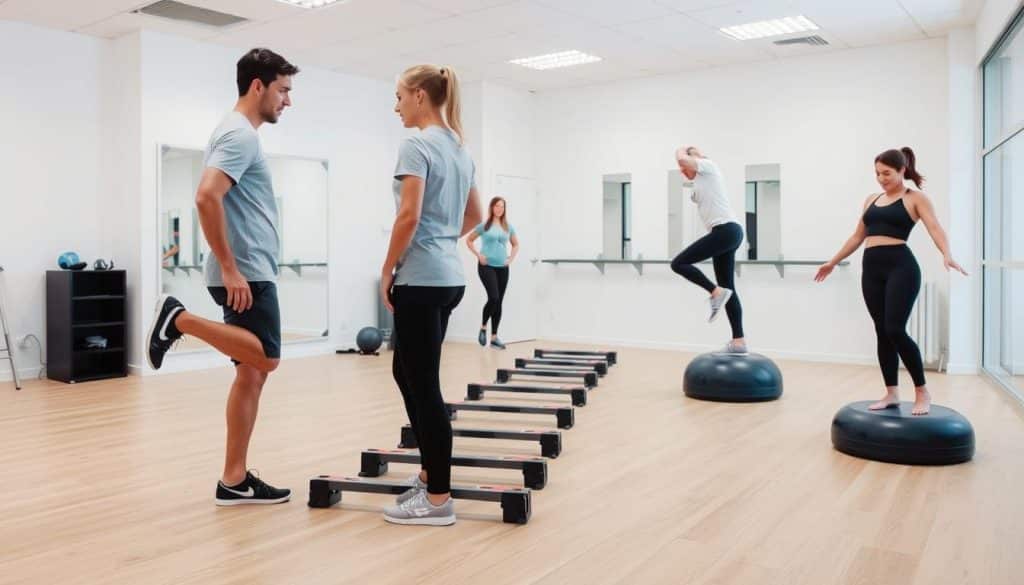
This neural-muscular partnership goes beyond basic balance. While balance keeps you steady, coordinated movement requires your central and peripheral nervous systems to work in sync. It’s what lets you pivot during a basketball layup or adjust stride mid-run without losing speed.
Our Calgary-based therapists use targeted activities that serve dual purposes: rebuilding after injuries and sharpening competitive edge. These methods improve how quickly your body interprets and responds to challenges—whether catching an uneven surface or reacting to an opponent’s move.
Key components enhanced through these practices include:
- Dynamic balance during complex maneuvers
- Agility in rapid direction changes
- Reaction time to unexpected stimuli
- Energy-efficient motion patterns
The science is clear—strengthening neural pathways creates more adaptable athletes. By upgrading how your systems communicate, you develop resilience against injuries and refined control over every movement.
Understanding Coordination Training Importance for Athletes
Every elite performer knows: fluid motion patterns determine outcomes more than isolated strength gains. At Riverside Sports Therapy, we design programs that teach your body to work as a unified system, not just a collection of muscles.
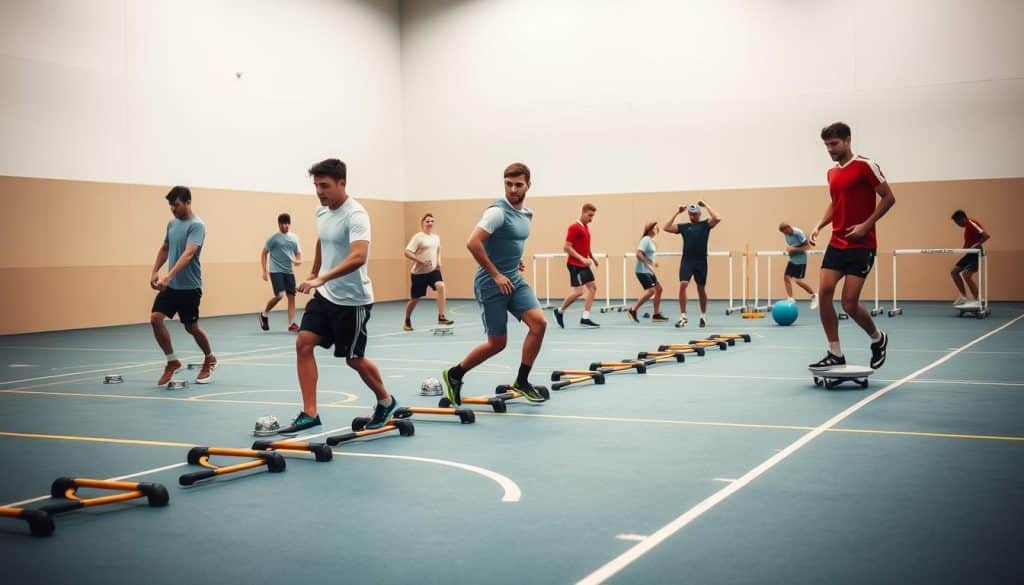
What Makes Movement Effective?
Dynamic exercises activate your brain-body connection through multi-directional challenges. Think ladder drills sharpening a soccer player’s footwork or medicine ball throws improving a volleyball spike. These activities build neural pathways that make complex actions feel automatic during competition.
Game-Changing Results
Our Calgary athletes experience measurable improvements in three key areas:
- Quicker response to opponents’ moves through enhanced spatial awareness
- 25% faster recovery from directional changes in field sports
- Reduced joint stress through optimized force distribution
These adaptations don’t just boost your current abilities – they create lasting physical intelligence. Your body learns to anticipate challenges, whether executing a perfect golf swing or adjusting stride mid-sprint.
Integrating Coordination Exercises into Sports Therapy
What separates good athletes from great ones? Neural-muscular harmony. At Riverside Sports Therapy, we build this connection through structured routines that mirror real-game demands while addressing individual recovery needs.
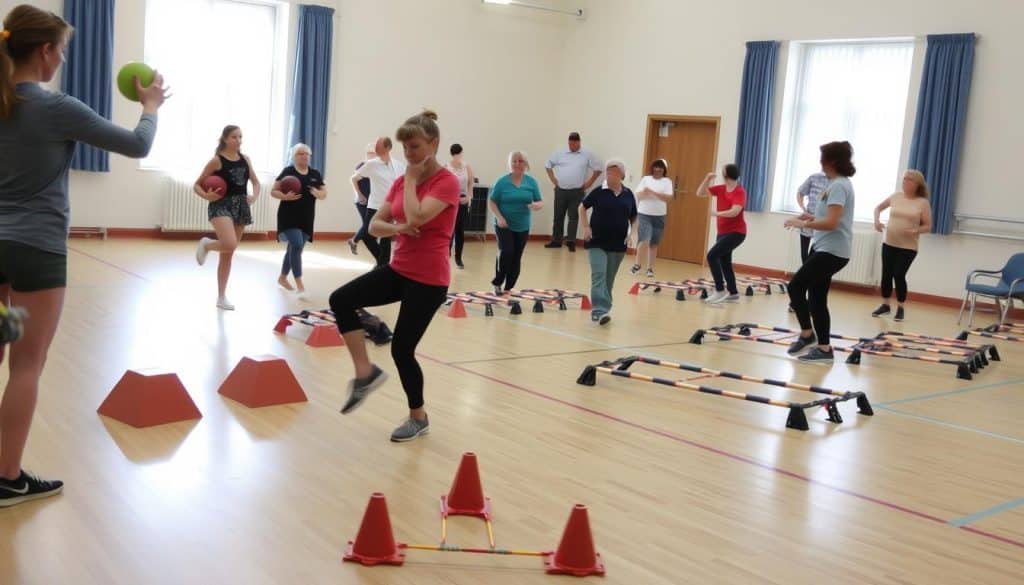
Neuromuscular Activation and Functional Movement
Our Calgary therapists blend sport-specific actions with cognitive challenges. Squats become balance tests when performed on unstable surfaces. Lunges transform into precision drills with visual tracking tasks.
These methods activate your body’s stabilization systems. Multiple muscle groups engage simultaneously, building functional strength while sharpening spatial awareness. You’ll feel improvements in how you pivot, reach, and react during play.
Enhancing Strength and Balance Naturally
Dynamic routines replace isolated lifts. Step-ups with rotational throws develop core stability. Single-leg reaches improve joint control. Each session progresses from basic patterns to complex sequences matching your sport’s requirements.
Three key benefits emerge:
- Better proprioception for safer landings and cuts
- Energy-efficient motion patterns that reduce fatigue
- Adaptive core engagement across multiple movement planes
This approach builds durable athletes. Whether rehabbing a shoulder injury or preparing for playoffs, your program evolves with your capabilities. Movements become precise. Reactions turn instinctive. Performance gains follow.
Practical Examples of Coordination Drills
Mastering movement requires more than theory—it demands action. At our Calgary clinic, we implement drills that translate science into sport-specific results. These methods address real-game scenarios while building adaptable physical intelligence.
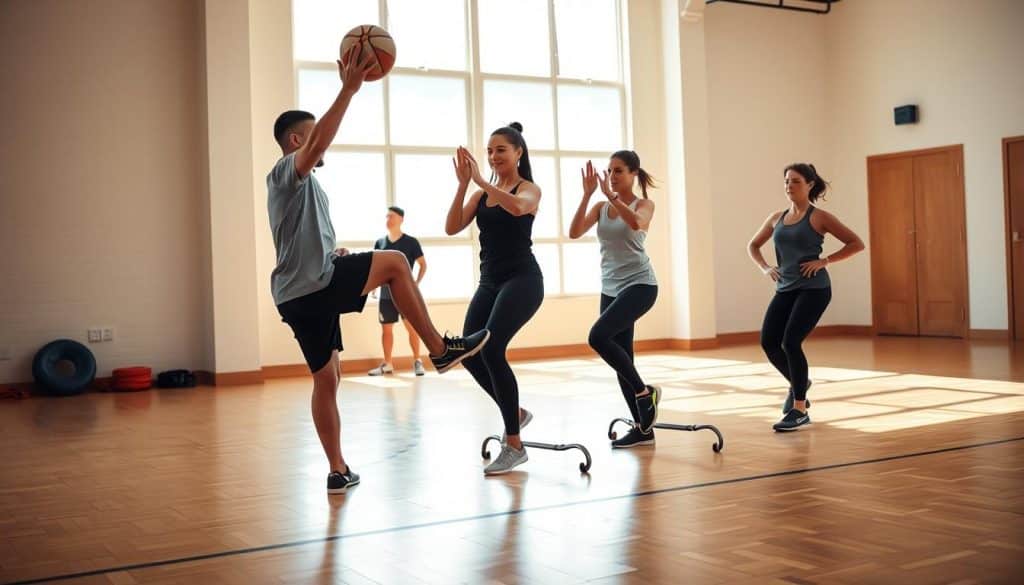
Drills to Improve Reaction Time and Balance
Shuttle runs teach rapid acceleration and controlled stops. You’ll alternate between sprints and sudden direction changes, mimicking hockey breakaways or soccer transitions. Reaction ball work adds unpredictability—catching erratic bounces sharpens decision-making under pressure.
Using Functional Movements for Improved Coordination
Cone weaving drills build precise footwork for basketball crossovers or tennis volleys. Medicine ball throws challenge stability during rotational movements. You’ll develop power while maintaining alignment, essential for baseball swings or golf drives.
Impact on Speed and Agility During Workouts
Ladder drills boost foot speed for football receivers and rugby players. Obstacle courses combine jumping, crawling, and pivoting—skills needed for trail running or martial arts. These sequences improve how quickly you adapt to changing environments.
Key benefits our athletes experience:
- 15% faster directional changes after 6 weeks of shuttle drills
- Improved balance during uneven surface navigation
- Enhanced hand-eye synchronization through ball work
Enhancing Posture and Reducing Injury Risk
Ever notice how slouching at your desk affects your workout? At Riverside Sports Therapy, we bridge this gap between daily habits and athletic performance. Our methods target the root causes of poor alignment to help you move freely and safely.
Correcting Postural Misalignments Through Exercise
Your spine isn’t meant to stay rigid. Our Calgary therapists use dynamic routines that rebuild natural curves. Core stabilization drills activate muscles supporting your lower back. Shoulder blade squeezes counter slouching from screen time.
Three key improvements occur:
- Stronger mid-back muscles combat rounded shoulders
- Pelvic alignment exercises reduce lower back strain
- Neck mobility work eases tech-related tension
Injury Prevention Through Improved Movement Patterns
Flawed mechanics strain joints over time. We teach safer ways to bend, twist, and lift. Balance boards reveal hidden weaknesses. Resistance bands train proper knee tracking during squats.
You’ll experience:
- 30% less ankle instability in pivoting sports
- Reduced hamstring tightness from better hip engagement
- Decreased shoulder pain through scapular control
Our athletes report lasting changes. One hockey player eliminated chronic back pain by strengthening dormant core muscles. A runner corrected her stride to prevent knee injuries. Your body learns to protect itself – naturally.
Boosting Cognitive Function Through Coordinated Movement
Your brain’s performance matters as much as your squat max. At Riverside Sports Therapy, we help Calgary athletes and active people unlock mental sharpness through coordinated movement challenges that fire up neural networks. These methods strengthen how your nervous system interprets and executes physical tasks.
Brain and Muscle Communication Benefits
Dynamic drills act like system updates for your neural pathways. When catching a reaction ball mid-lunge, your brain processes visual cues, balance adjustments, and muscle activation simultaneously. This cross-training strengthens your body’s command center:
- 15% faster decision-making during split-second plays
- Improved accuracy in complex movement sequences
- Enhanced skill acquisition through strengthened neural pathways
Mental Clarity and Reduced Stress
The focus required for coordinated movements creates a meditation-like effect. As you concentrate on precise footwork patterns, cortisol levels drop while endorphins rise. Our clients experience:
- Clearer strategic thinking during overtime periods
- Better stress management for people in high-pressure roles
- Improved recovery through mindful movement practices
Regular practice helps people maintain cognitive reserves that benefit sports and daily life. You’ll process information quicker during games and multitask efficiently off-field – proof that coordinated movement trains more than muscles.
Connect With Riverside Sports Therapy
Transform how you move with guidance from Calgary’s sports therapy experts. Our team at Riverside Sports Therapy crafts action plans that align with your unique physical demands and aspirations. Located in the heart of Alberta, we blend hands-on experience with cutting-edge methods to help you move smarter.
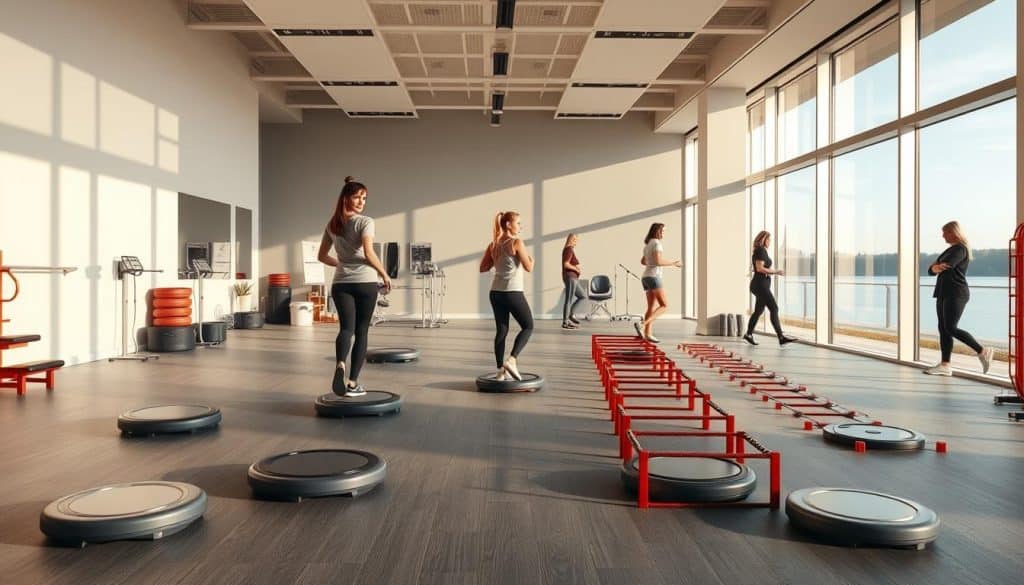
Tailored Solutions for Active Lifestyles
Your journey begins with a detailed assessment at our Calgary clinic. We map your current abilities and design progressive strategies targeting your sport’s specific challenges. Whether you’re rebuilding after an injury or chasing podium finishes, your plan evolves as you do.
What sets our approach apart:
- Movement analysis identifying efficiency gaps
- Step-by-step skill development across multiple planes
- Real-time feedback during dynamic exercises
- Home practice routines fitting busy schedules
Reach our specialists at (403) 283-7551 to start refining your physical intelligence. We’ll help you build movement patterns that enhance performance while protecting joints from strain. Lasting change happens when practice meets purpose – let’s create yours.
Conclusion
Movement functions as your body’s universal language. At Riverside Sports Therapy, we decode this dialogue between brain and muscle to unlock your full physical potential. Our methods refine how you interpret spatial challenges and execute precise responses.
Enhanced movement strategies benefit everyone. Young competitors develop sharper reflexes for split-second plays. Active adults maintain stability during daily tasks. Older individuals build confidence through improved balance and reaction skills.
These practices create lasting advantages. Your body learns to distribute force efficiently, reducing joint strain during high-intensity activities. Mental clarity grows as neural pathways strengthen, helping you process information faster under pressure.
Our Calgary-based approach addresses individual needs while promoting whole-body wellness. Whether recovering from injury or pursuing personal records, optimized movement patterns become your foundation for success. Better physical intelligence means lasting vitality – in sports and everyday life.
